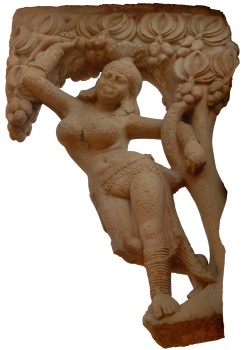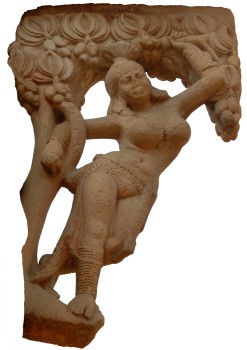
|
Symbolic numbers in
|

|
|

|
Symbolic numbers in
|

|
|
|
When read for the first time, in whatever language, Tantric materials such as the Kālacakra Tantra often seem impenetrable. These texts were written in verse for ease of memorisation and use highly symbolic language, and are therefore only understandable by readers very familiar with the subject. One aspect of this that is particularly frequent in the Kālacakra literature, and that can cause difficulty, is the use of symbolic words for numbers (Dan Martin calls these "numeric code-words"; these are sometimes also called chronograms, but that is not the usual use of the term). The following verse can serve as an example. This is from Jonang liturgies, and was adapted for such use by Dolpopa Sherab Gyaltsen from the second verse of the fourth chapter of the Kālacakra Tantra. Dolpopa changed a few words to fit a liturgical context:
Six shoulders, sun upper arms and Jina hands, zero, six and fire knuckles; The legs playfully trample terrified Māra and Rūdra, on disks of sun, moon and flames; Homage to unique Kālacakra, the identity of worldly and unworldly."
phrag pa drug dang nyi ma'i dpung pa rgyal ba'i phyag gi padma stong pa drug dang me yi tshigs // zhabs dag gis ni zla ba nyi ma sreg za'i dkyil 'khor dag la bdud dang drag po skrag bzhin pa // rol pas mnan pa'i srid med srid pa mnyam pa dus kyi 'khor lo gcig pu de la phyag 'tshal lo // The language used in this verse clearly needs explanation, and it is the use of symbolic words in place of numbers that is the main obstacle to understanding. Paraphrased, the verse states: "Single body and pair of legs, triple throat and four glorious faces with different colours; six shoulders, twelve upper arms and twenty-four hands, zero, six and three (three hundred and sixty) knuckles; the legs playfully trample terrified Māra and Rūdra, on disks of sun, moon and Rāhu; Homage to unique Kālacakra, the identity of worldly and unworldly." The words that represent numbers in this verse are these: Usually, these symbolic words have an obvious relationship with the number they represent. For example, the word nāga (klu) is used for the number eight, there being eight nāgas in mythology. The word sky or space is used for the number zero, because of the emptiness of space, the word eye or hand is used for the number two, because most humans have two eyes and two hands, and so forth. The Kālacakra literature contains much material on astronomy and the calendar, and in these writings we see perhaps the greatest use of these symbolic words for numbers. As an example, the following is verse 27 from chapter one of the Kālacakra Tantra. This is at the beginning of the discussion of the calculation of the calendar, and is describing the first calculation – the number of lunar months that have elapsed since the epoch. In this translation, following the example of John Newman in his thesis on the first chapter of the Kālacakra Tantra, the number represented is given in brackets after the word representing it.
The years since the lord of the barbarian less hand (2) snake (8) Moon (1), the remainder should be multiplied by Sun (12). Adding the months since Caitra, multiply the lower by age (4), and divide by sky (0) fire (3) Moon (1). The quotient is added to the upper, and lord of men, yields the true number of months.
kla klo'i dbang po'i lo ni lag pa gdengs can zla bas dman pa'i lhag ma dag kyang nyi mas bsgyur // nag pa la sogs zla ba bsres te 'og tu dus kyis bsgyur ba mkha' me zla bas rnam par dbye // rnyed pa steng du bsres pa dag ni mi yi bdag po zla ba'i tshogs pa rnam par dag par 'gyur //
ūnaṃ mlecchendravaṣaṃ karaphaṇiśaśinā śeṣamarkāhataṃ ca / miśraṃ caitrādimāsairadharayugahataṃ khāgnicandrairvibhaktaṃ labdhaṃ mūrdhni praviṣṭaṃ bhavati narapate māsapiṇḍaṃ viśuddham // He not only gives a standard list of these symbolic names for numbers, he also gives explanations for some of them. Some examples follow: Fire – three. The three fires: the fire mountain around the great salt ocean, the fire of the Sun, and the fire that burns and consumes things. Pointed – three. This is a name for fire. Water-treasure – four. This refers to the four great oceans in the four directions. River – four. The four great rivers, Ganges, etc. Age/aeon – four. The four ages, or yugas. Arrow – five. The five arrows of Māra. These arrows have different effects or functions. Season – six. The six seasons, as given in Kālacakra literature: spring, summer, rains, autumn, pre-winter and winter. Mountain, continent – seven. The seven mountain ranges or seven rings of continents surrounding Mt Meru. Weekday – seven. The seven weekdays, Sunday, Monday, etc. Direction – ten. The ten directions, the four cardinal directions, the four intermediate, above and below. Ugliness – eighteen. The eighteen characteristics of ugliness, including: small forehead, yellow eyes, flat nose, pot-belly, short limbs, and so forth. The above is by no means a comprehensive list, but certainly serves to illustrate the principles of this use of symbolic names for numbers. Care certainly needs to be taken, particularly in the Tibetan language. There is a good example of possible ambiguity in the calendar description in the first chapter of the Kālacakra Tantra. In the space of just eight verses, the same Tibetan word, dus, is used to translate three different Sanskrit terms: yuga (age or aeon, see the verse quoted above), ṛitu (season), and, kāla (time). The Tibetan language simply cannot discriminate between these different meanings, and yet the first term represents the number four, the second the number six, and the third the number three (as in the three times of past, present and future). This is perhaps the worst and most obvious example, but there are others where similar care, principally reference to the Sanskrit original, needs to be taken in interpreting this type of material. E Henning. Last updated 13 July 2013. Return to home page. |